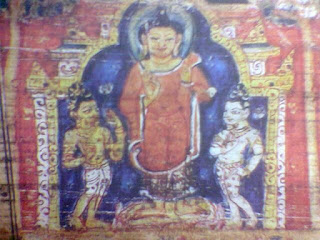Welcome to the sad World of Malaysian Discoveries...
Kota Gelanggi was the first capital of the ancient Empire of Srivijaya and dating to around 650–900 and one of the oldest Kingdoms in Malay Peninsula. The site's existence was announced as a discovery by the Malaysian press on 3 February 2005. (Source: Tracking down Kota Gelanggi (PDF). The Star. Retrieved May 16, 2016)
Ancient Tamil inscriptions show that the city was raided in 1025 by South Indian Chola Dynasty conqueror Rajendra Chola I. Earlier he had destroyed the Sri Vijaya Kingdom of Gangga Negara. The latter that is Gangga Negara is generally equated with the ruins and ancient tombs that can still be seen in Beruas, Perak.
Old European maps of the Malay Peninsula show the location of a city known as Polepi that is Gelanggi at the southern tip of the Malay Peninsula.
There was a wide publicity in the Malaysian media in 2005, about the Lost City of Kota Gelanggi and the painstaking efforts of Malaysian researcher Remy Che Ross to trace it.
In response to these media reports, the authorities indicated they would conduct an expedition in April 2005 to the site somewhere in Kota Tinggi, Johor to confirm the discovery and that the researcher Remy would be part of the expedition.
That was that. The ensuing dead silence over the whole issue has perplexed Remy and countless others including me who are following this event with much interest. The authorities now behave as if the discovery never happened at all.
We suspect that although the authorities may concur with Remy's findings, they are nevertheless reluctant to acknowledge his discovery. They feel that since the Lost City of Kota Gelanggi belongs to the era of Srivijaya more than 1,000 years ago, its glory of ancient Buddhist/Hindu civilisation would outshine that of the Malaccan era from which Malaysia's official history begun only 600 years ago.
From the perspective of these local historians, it is clear that with the discovery of Kota Gelanggi, history would definitely have to be rewritten in that the Malaccan era would have to be replaced as the starting point of Malaysian history.
However, political and religious imperatives make the authorities unwilling to rewrite Malaysian history to begin from the era of Srivijaya because that would mean undermining the prominence which the government has given to Malacca in Malaysian history.
Kota Gelanggi and Remy's painstaking efforts at discovering remnants of a by-gone glorious Indian/Buddhist era are therefore on the verge of being shamelessly sacrificed and buried.
History, therefore, will not be re-written. As this would mean Malacca has to play the second fiddle to the Buddhist/Hindu Kota Gelanggi.
Had Kota Gelanggi been an other non Indian civilisation, the authorities would no doubt have widely highlighted and publicised it and Remy would be an instant celebrity today with something in front of his name.
Unfortunately, it is not.
Still, Remy should not be unduly disappointed by the decision of the authorities not to give Kota Gelanggi its proper due in Malaysian history. Sooner or later, his painstaking efforts will be internationally recognised. He has already taken the first step of having his findings published in well-acclaimed overseas journals. International recognition is certainly better than local recognition.
References to Kota Gelanggi were reported in the late 19th and early 20th centuries by colonial scholar-administrators. Dudley Francis Amelius Hervey (1849–1911), published eye witness reports of the city in 1881. Sir Richard Olof Winstedt (1878–1966) stated that an Orang Asli was prepared to take people to the site in the late 1920s. Adventurer-explorer Gerald Gardner (1884–1964) discovered the ruins of Johore Lama while searching for Kota Gelanggi.
Ancient Tamil inscriptions show that the city was raided in 1025 by South Indian Chola Dynasty conqueror Rajendra Chola I. Earlier he had destroyed the Sri Vijaya Kingdom of Gangga Negara. The latter that is Gangga Negara is generally equated with the ruins and ancient tombs that can still be seen in Beruas, Perak.
Old European maps of the Malay Peninsula show the location of a city known as Polepi that is Gelanggi at the southern tip of the Malay Peninsula.
In response to these media reports, the authorities indicated they would conduct an expedition in April 2005 to the site somewhere in Kota Tinggi, Johor to confirm the discovery and that the researcher Remy would be part of the expedition.
We suspect that although the authorities may concur with Remy's findings, they are nevertheless reluctant to acknowledge his discovery. They feel that since the Lost City of Kota Gelanggi belongs to the era of Srivijaya more than 1,000 years ago, its glory of ancient Buddhist/Hindu civilisation would outshine that of the Malaccan era from which Malaysia's official history begun only 600 years ago.
However, political and religious imperatives make the authorities unwilling to rewrite Malaysian history to begin from the era of Srivijaya because that would mean undermining the prominence which the government has given to Malacca in Malaysian history.
History, therefore, will not be re-written. As this would mean Malacca has to play the second fiddle to the Buddhist/Hindu Kota Gelanggi.
Had Kota Gelanggi been an other non Indian civilisation, the authorities would no doubt have widely highlighted and publicised it and Remy would be an instant celebrity today with something in front of his name.
Still, Remy should not be unduly disappointed by the decision of the authorities not to give Kota Gelanggi its proper due in Malaysian history. Sooner or later, his painstaking efforts will be internationally recognised. He has already taken the first step of having his findings published in well-acclaimed overseas journals. International recognition is certainly better than local recognition.








